8
Collie Woollen Mills in Appleton, Ontario. Photo by Malak Karsh1945-1946
Appleton, Town of Mississippi Mills, Ontario, Canada
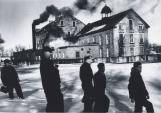 Credits:
Credits:North Lanark Regional Museum (2012.79.12.28)
Photographer: Malak Karsh
Donated by Eleanor Wright & Irene Dunn Thompson
9
The Caldwell Woollen Mill had lain dormant for several years and most of the skilled workers had moved to other mills or new jobs. In order to get the mills operating again the Collies needed mechanics, electricians, skilled looms people and weavers. Some of these positions were staffed by local residents who had worked at the Caldwell Mill, or had experience at mills in Carleton Place or Almonte, but even so more skilled labour was needed. Members of the Collie family travelled back to the U.K. to recruit more skilled workers. Employment at the mill was important to Appleton's economy. Once the small group of skilled workers got the mill functional more men and women from Appleton and the surrounding communities were hired and trained to work at the mill.The Collie Woollen Mill was a driving force in Appleton's economy.
10
Houses built by the Collie family in 1945 for mill employees. Photo by Malak Karsh1945-1946
Appleton, Town of Mississippi Mills, Ontario, Canada
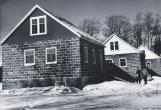 Credits:
Credits:North Lanark Regional Museum (2012.79.12.32)
Photographer: Malak Karsh
Donated by Eleanor Wright & Irene Dunn Thompson
11
Creating a functioning mill also meant fixing equipment and purchasing new machines as necessary. The equipment was typically North American made since the textile industry in the United Kingdom and Europe produced a different width of cloth. William Collie travelled to the Carolinas, Georgia and Tennessee to buy most of his equipment and would often bring his children along on these trips. When equipment broke down he Collie's often brought in technicians from the States to make the repairs.Mr. Collie also purchased equipment from closed mills.
12
One of the first things William Collie did when he acquired the Mill was to petition for hydro. At the time of purchase the mill was using electricity generated by a water turbine installed by the Caldwells. At the time, this turbine generator was the only source of electricity in Appleton and it generated power for the mill as well as limited power for a few houses and stores in Appleton.In 1937 the Collie Woollen Mill reached an agreement with Ontario Hydro Electric Power Corporation to have hydro brought to Appleton. In order to facilitate the agreement, the Collie's agreed to shut down their turbine generator so that Ontario Hydro would be the only supplier of electricity in Appleton. In 1937 Ontario Hydro build a dam on the Mississippi River, next to the woollen mill, in order to generate hydro-electricity.
In 1994, a newer hydroelectric facility was built on the Mississippi River on the site of the former Collie Woollen Mill. This new hydro dam uses three turbines and generators to produce an average of 6300 megawatt hours each year.
13
Woollen Mills, Appleton (Pre-1939). Waterwheel generator housed building on leftCirca 1880-1939
Appleton, Town of Mississippi Mills, Ontario, Canada
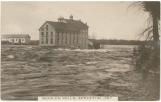 Credits:
Credits:North Lanark Regional Museum (2011.15.2)
Donated by Wendy Leblanc
14
Only two years after the Collie Woollen Mills began production World War Two began. The war was a major boost to the local economy. The mill shifted to 24 hour a day production in order to fill the military contracts. The mill produced woollens for uniforms, blankets and other military needs.The war deeply affected the community of Appleton as sons and daughters enlisted to protect their country while families worked extra shifts at the mill
15
When the war was over, the community prepared an honor roll that hung in the Appleton Community Hall. The honor roll now resides at the North Lanark Regional Museum in Appleton:This honor roll, which hung in the Appleton Community Hall until it was destroyed by fire, commemorates those Appleton residents who volunteered for active service during World War II. A silver star denotes those soldiers who gave their lives.
Bert Aitken
Stewart Aitken
John Barden
Leslie Barden
Gertrude Blaney
Earle Bridges
Frank Cavers (*)
Harold Cavers
Melville Cavers
John Collie
Jean Collie
Henry Collie
Forest Dezell
Harold Dowdall
Gordon Duncan
Hugh Duncan
Kenneth Duncan
Robert Duncan (*)
William Duncan
Arthur Fee
Elizabeth Fitzpatrick
Leonard Ford
Jack Gallagher
James Galvin
Jack Gladish
Max Gladish
Gordon Hallahan
Rupert Hopkins
William B. Hopkins
Russell James (*)
Hugh Kennedy
Earle Lowe
Stewart Neil
Bernard Pye
James Pye (*)
Keith Salisbury
Clyde Service
Ralph Sinnett
Harold Snedden
Lawrence Spinks
Leonard Spinks
Eric Stead
Neil Stewart
Raymond Struthers
William Struthers
George Walkley
16
In an interview with Lenny Spinks by Eleanor Wright on July 30, 2012 at the North Lanark Regional Museum, Lenny Spinks explains how important the mill production was. "Andy" refers to Andy Gladish, the local blacksmith at the time.[Lenny] "During the war I worked in Collies Mill and I worked practically day and night because the men were pretty well all gone. I was only a boy then, sixteen, you know, seventeen. [...] something would break at two or three in the morning and Mr. Hutchinson would say, 'Lenny you get that fixed.' So, I'd have to take that [broken piece] and go up to Andy's house, carry it up, cog wheel or something, and wake him out of bed. And he'd say yes, he'd get up. And I'd go back to the blacksmith forge. And he'd start the forge up. And he'd repair that. Suppose this was two, three, four, five o'clock in the morning. Take it back and get that machine going. Because at that time we were making cloth for the army, army uniforms eh."
[Eleanor] "Right"
[Lenny] "And it was a big push all the time. Day and night."
17
Eleanor McMunn dyer at Collie Woollen Mills. Photo by Malak Karsh1945-1946
Appleton, Town of Mississippi Mills, Ontario, Canada
 Credits:
Credits:North Lanark Regional Museum (2012.79.12.24)
Photographer: Malak Karsh
Donated by Eleanor Wright & Irene Dunn Thompson
18
Agnes Cavers and Edith Dowdall. Burling was done in the "old mill". Photo by Malak Karsh1945-1946
Appleton, Town of Mississippi Mills, Ontario, Canada
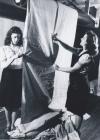 Credits:
Credits:North Lanark Regional Museum (2012.79.12.23)
Photographer: Malak Karsh
Donated by Eleanor Wright & Irene Dunn Thompson
19
The War also had an effect on the Mill's workforce. With so many men off to war and the high demand for production many women were hired on at the mill on the production line instead of just in the administration offices. Female staff continued on at the Mill even after the end of the war. They worked throughout the factory as machine operators, in administration and in the dye shop. Collie Woollen Mills was the first and only woollen mill in Canada to hire a female dyer at the time.In an interview at the North Lanark Regional Museum on July 23, 2012, Stephen Collie recalls that his grandfather, William Collie used to say: "When it came to detail, the women were far better, the men were less concerned." This was especially important when catching a run or flaws in the weave to maintain quality standards.
20
In 1940, with business booming, the Collie family decided to expand the woollens mills and built a new factory about 150 meters west of the stone mills, behind the Robert Teskey house. This 90 x 45 metre block building was built for efficiency and electricity. Between 1940 and 1942 two storage lagoons were dug to hold effluent from the factory production.This modern plant was used for the majority of the production while the old stone mills became the finishing department and the administration office. The new mill became known as the "upper mill" while the stone mills became known as the "lower mill."
21
View of Collie Woollen Mill from the dam on the Mississippi River in 19461946
Appleton, Town of Mississippi Mills, Ontario, Canada
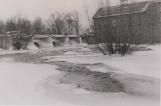 Credits:
Credits:Mississippi Valley Textile Museum (2011.39.14)
Donated by Isobel Collie in memory of her husband Jack Collie